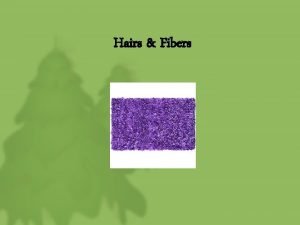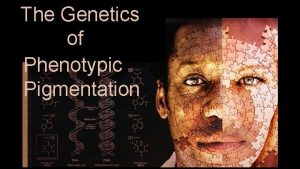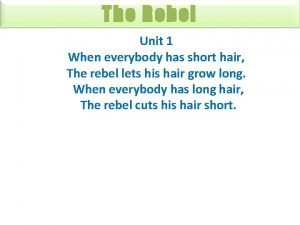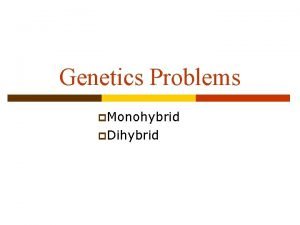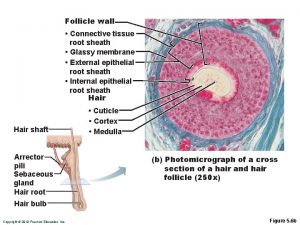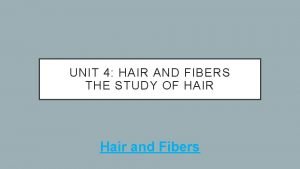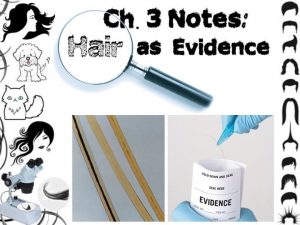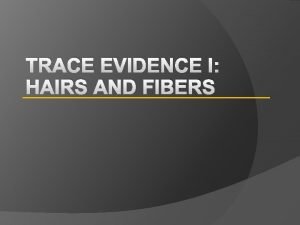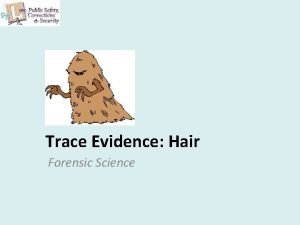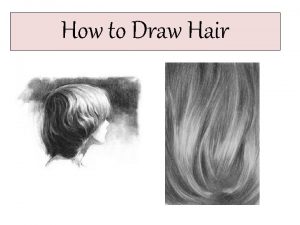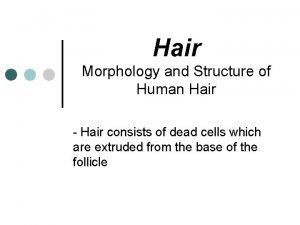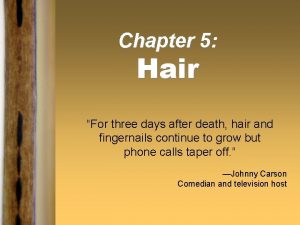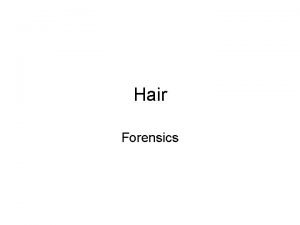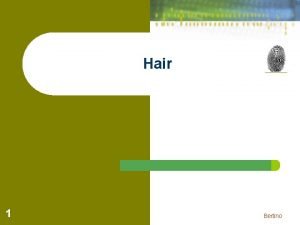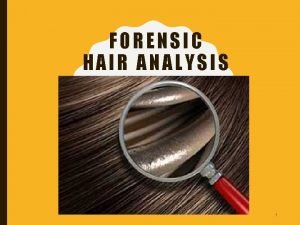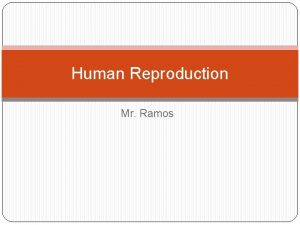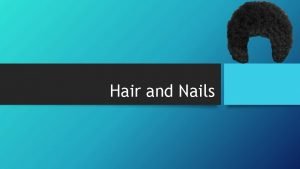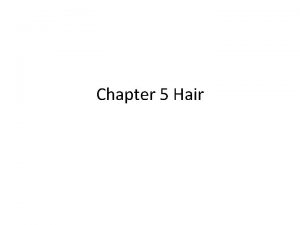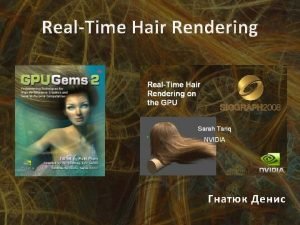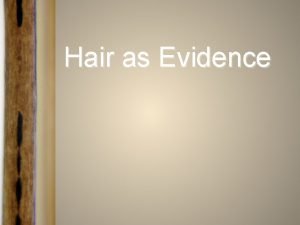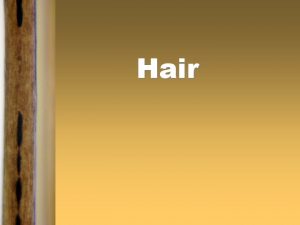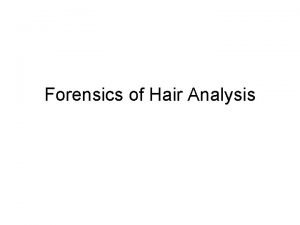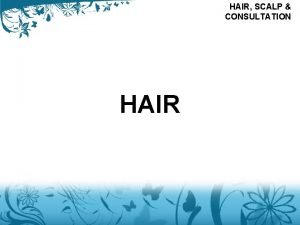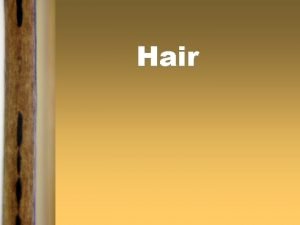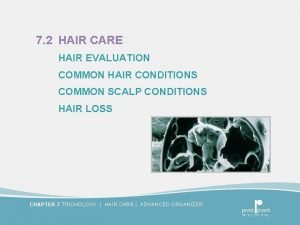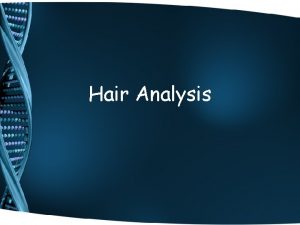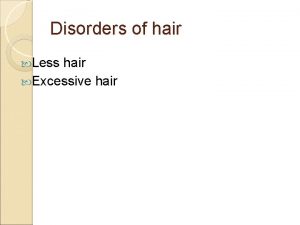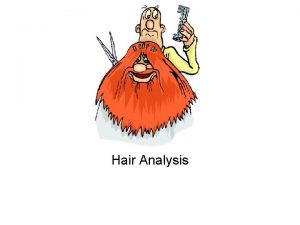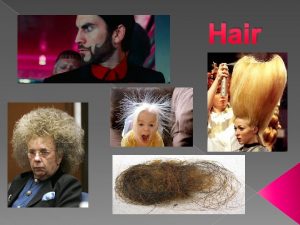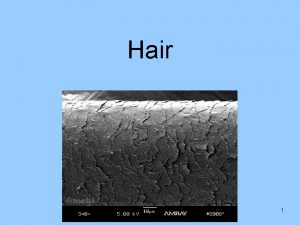Chapter 3 Hair Introduction Human hair is one












































- Slides: 44

Chapter 3: Hair

Introduction § Human hair is one of the most frequently found pieces of evidence at the scene of a violent crime. It can provide a link between the criminal and the crime. § From hair one can determine: § § § If the source is human or animal Race (sometimes) Origin of the location on the source’s body Whether the hair was forcibly removed If the hair has been treated with chemicals If drugs have been ingested Kendall/Hunt Publishing Company 1

The Structure of Hair Forensic Science: Fundamentals & Investigations, Chapter 3 2

Skin Structure Kendall/Hunt Publishing Company 3

Hair Shaft Composed of: § Cuticle—outside covering, made of overlapping scales § Cortex—inner layer made of keratin and imbedded with pigment; also contains air sacs called cortical fusi § Medulla—inside layer running down the center of the cortex Kendall/Hunt Publishing Company 4

Cuticles, Cortex, and Medulla Forensic Science: Fundamentals & Investigations, Chapter 3 5

The Cuticle The cuticle is the outermost layer of hair which is covered with scales. The scales point toward the tip of the hair. Scales differ between species of animals and are named based on their appearance. The three basic patterns are: § Coronal § Spinous § Imbricate Kendall/Hunt Publishing Company 6

Human Scales In order to visualize the scales: § paint clear fingernail polish on a glass slide § when the polish begins to dry, place a hair on the polish § when almost dry, lift off the hair and observe the scale imprints What pattern is seen in this slide? Kendall/Hunt Publishing Company 7

The Cortex The cortex gives the hair its shape. It has two major characteristics: § Melanin—pigment granules that give hair its color § Cortical fusi—air spaces, usually found near the root but may be found throughout the hair shaft Kendall/Hunt Publishing Company 8

Types of Medulla The medulla is the hair core that is not always visible. The medulla comes in different types and patterns. Forensic Science: Fundamentals & Investigations, Chapter 3 9

Human Medulla Human medulla may be continuous, fragmented or absent. Kendall/Hunt Publishing Company 10

Medullary Index Determined by measuring the diameter of the medulla and dividing it by the diameter of the hair. mouse § Medullary Index for human hair is generally less than 1/3. § For animal hair, it is usually greater than 1/2. Kendall/Hunt Publishing Company 11

Medulla Index— Animals vs. Humans Forensic Science: Fundamentals & Investigations, Chapter 3 12

Hair Shape Can be straight, curly or kinky depending on the cross-section, which may be round, oval or crescent-shaped Round (Straight) Oval (Curly) Kendall/Hunt Publishing Company Crescent moon (Kinky) 13

Hair Growth § § Terminology § Anagen—hair that is actively growing; lasting up to 5 years § § Catagen—hair is not growing; a resting phase Telogen—hair that is dying and ready to fall out; lasting two to six months Grows about 0. 5 mm per day or 1 centimeter per month; approximately one half inch per month. Hair does NOT grow after death. Kendall/Hunt Publishing Company 14

The Root Human roots look different based on whether they have been forcibly removed or if they are telogen hairs and have fallen out. Animal roots will vary, but in general have a spear shape. Fallen out Forcibly removed Kendall/Hunt Publishing Company 15

Types of Hair Buckled Blunt Double Medulla ‡ A cross section: circular, triangular, irregular, or flattened ‡ Shape: influences the curl of the hair ‡ Texture: coarse or fine Forensic Science: Fundamentals & Investigations, Chapter 3 16

Racial Differences ‡ Broad, racial groups do exhibit some shared physical characteristics ‡ But NOT applicable to all individuals in these groups Therefore, ‡ Individual hairs CANNOT be assigned to any of these groups 17 Forensic Science: Fundamentals & Investigations, Chapter 3

Ethnic Hair African Asian Caucasian African Forensic Science: Fundamentals & Investigations, Chapter 3 18

Animal Hair and Human Hair ‡ Pigmentation: ‡ animal hair is denser toward the medulla ‡ human hair tends to be denser toward the cuticle ‡ Banded Color Patterns: ‡ possible in animals ‡ not in humans ‡ Medulla: much thicker in animals Forensic Science: Fundamentals & Investigations, Chapter 3 19

Human Hairs

Horse Hair

Dog Hair

Cat Hair

Mouse Hair

Rabbit Hair

Deer Hair

Cow Hair

Pig Hair

Special Conditions of Hair The following slides show the ends of several different species of hairs

Fallen Out Hairs

Natural Tip

Pulled Out-By the Root

Broken-Torn

Cut Hair

Pubic Hair Forensic Science: Fundamentals & Investigations, Chapter 3 35

Hair Comparison § § Color Length Diameter Distribution, shape and color intensity of pigment granules § Dyed hair has color in cuticle and cortex § Bleaching removes pigment and gives a yellow tint § Scale types § Presence or absence of medulla § Medullary type § Medullary pattern § Medullary index Kendall/Hunt Publishing Company 36

DNA from Hair § The root contains nuclear DNA. If the hair has been forcibly removed, some folicular tissue may be attached containing DNA. § The hair shaft contains abundant mitochondrial DNA, inherited only from the mother. It can be typed by comparing relatives if no DNA from the body is available. This process is more difficult and costly than using nuclear DNA. Kendall/Hunt Publishing Company 37

Collection of Hair § Questioned hairs must be accompanied by an adequate number of control samples. § from victim § from possible suspects § from others who may have deposited hair at the scene § Control Sample § 50 full-length hairs from all areas of scalp § 24 full-length pubic hairs Kendall/Hunt Publishing Company 38

Hair Toxicology § Advantages: § Easy to collect and store § Is externally available § Can provide information on the individual’s history of drug use or of poisoning. § Collections must be taken from different locations on the body to get an accurate timeline. Kendall/Hunt Publishing Company 39

Testing for Substances in the Hair Shaft ‡ Chemical tests ‡ presence of various substances ‡ Examining a hair shaft ‡ timeline for exposure to toxins ‡ Neutron Activation Analysis (NAA) ‡ concentrations of substances Forensic Science: Fundamentals & Investigations, Chapter 3 40

Testing the Hair Follicle ‡ Microscopic assessment ‡ Cost effective and quick ‡ Blood test ‡ Determine blood type ‡ DNA analysis ‡ Identification with a high degree of confidence Forensic Science: Fundamentals & Investigations, Chapter 3 41

Hair Toxicology § Napoleon died in exile in 1821. By analyzing his hair, some investigators suggest he was poisoned by the deliberate administration of arsenic; others suggest that it was vapors from the dyes in the wallpaper that did him in. Kendall/Hunt Publishing Company 42

Microscopic Assessment ‡ Preparation Forensic Science: Fundamentals & Investigations, Chapter 3 43
 Hair morphology
Hair morphology One god one empire one religion
One god one empire one religion Little dog run
Little dog run One king one law one faith
One king one law one faith One god one empire one emperor
One god one empire one emperor One ford plan
One ford plan See one do one teach one
See one do one teach one See one, do one, teach one
See one, do one, teach one Twelfth night speeches
Twelfth night speeches See one do one teach one
See one do one teach one Asean tourism strategic plan
Asean tourism strategic plan Graphic organizer with the aims of la liga filipina
Graphic organizer with the aims of la liga filipina Cna chapter 8 human needs and human development
Cna chapter 8 human needs and human development Chapter 8 human needs and human development
Chapter 8 human needs and human development Human resource management chapter 1
Human resource management chapter 1 Chapter 1 introduction to human resource management
Chapter 1 introduction to human resource management Waistline
Waistline Chapter 1 introduction to anatomy and physiology
Chapter 1 introduction to anatomy and physiology Dark hair and blonde hair parents
Dark hair and blonde hair parents Tacheometric
Tacheometric What does the rebel do when others keep their hair short
What does the rebel do when others keep their hair short Hair grows in diagonal tubes called hair
Hair grows in diagonal tubes called hair Heterozygous tabby x stripeless
Heterozygous tabby x stripeless Glassy membrane of hair follicle
Glassy membrane of hair follicle The two primary parts of hair are the hair fiber and the:
The two primary parts of hair are the hair fiber and the: What is the medulla of the hair
What is the medulla of the hair Cat cuticle pattern
Cat cuticle pattern The medullary index of human hair is _____.
The medullary index of human hair is _____. Somatic origin of hair
Somatic origin of hair Peruvian human hair weave
Peruvian human hair weave Hair outline
Hair outline Hair consists of two parts
Hair consists of two parts Human hair roots demonstrate a wineglass morphology.
Human hair roots demonstrate a wineglass morphology. Deer medulla pattern
Deer medulla pattern Double medulla hair
Double medulla hair Forensic
Forensic A human hair is approximately 50 μm in diameter
A human hair is approximately 50 μm in diameter Human vs non human bones
Human vs non human bones Human development index definition ap human geography
Human development index definition ap human geography Human nouns
Human nouns Introduction to human communication
Introduction to human communication Human digestive system introduction
Human digestive system introduction Human reproduction introduction
Human reproduction introduction Intro to hrm
Intro to hrm Human resource planning introduction
Human resource planning introduction
